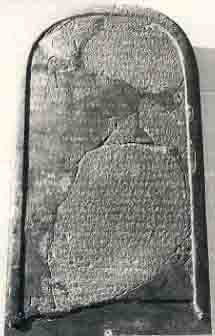Editor, H. S. (2002;2002). BAR 20:03 (May/June 1994). Biblical Archaeology Society.
"House of David" Restored in Moabite Inscription
A new restoration of a famous inscription reveals another mention of the "House of David" in the ninth century B.C.E.
By André Lemaire

Louvre Museum
THE MESHA STELA claims a ninth-century B.C.E. victory for the Moabite king Mesha over the Israelites. Mesha says he conquered Israelite territory east of the Jordan and humiliated the tribe of Gad. Among the mentioned towns was the place where the stela was found in 1868, the city of Dibon. 2 Kings 3:4 tells of a ninth-century Moabite rebellion, but it may not be the same as the fighting recorded on the Mesha stela.
Made of black basalt, the Mesha stela stood about 3 feet high. The 34 lines of Moabite script in the Moabite language (very close to Hebrew) make the Mesha stela the longest monumental inscription ever found in Palestine. Shortly after its discovery, the stela was smashed. A young French diplomat and amateur archaeologist, Charles Clermont-Ganneau (1846-1923) tracked down and acquired the pieces and attempted to reconstruct the stela. In the photo, the smooth areas of the stela mark Clermont-Ganneau's reconstructions based on a paper impression made before the stela was smashed.
The recent discovery at Tel Dan of a fragment of a stela containing a reference to the "House of David" (that is, the dynasty of David) is indeed sensational and deserves all the publicity it has received.1 The Aramaic inscription, dated to the ninth century B.C.E., was originally part of a victory monument erected at Dan, apparently by an enemy of both the "King of Israel" (also referred to in the fragment) and the "[King of the] House of David."
The inscription easily establishes the importance of Israel and Judah on the international scene at this time–no doubt to the chagrin of those modern scholars who maintain that nothing in the Bible before the Babylonian exile can lay claim to any historical accuracy.
1 "'David' Found at Dan," BAR 20:02.
next page >
page 1:11
 
|
Biblical Archaeology Review
This article is part of the Biblical Archaeology Review Archive CD-ROM. Click here to learn more.
|
|